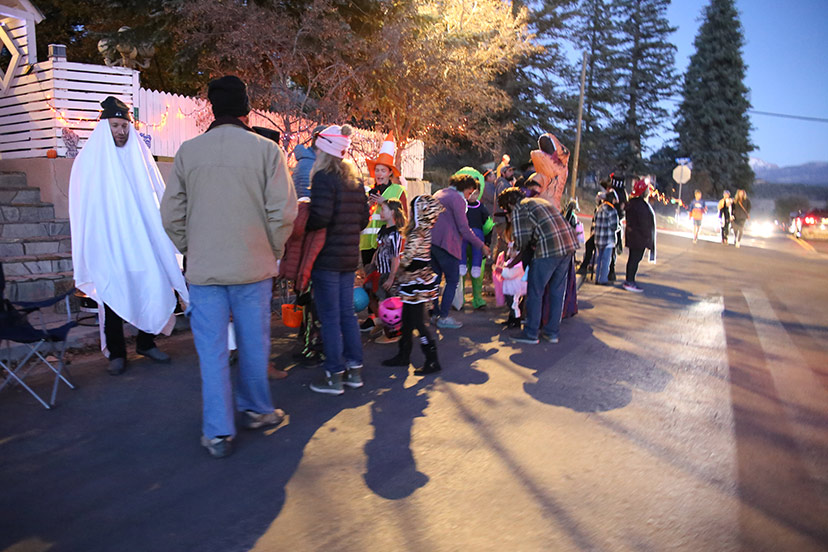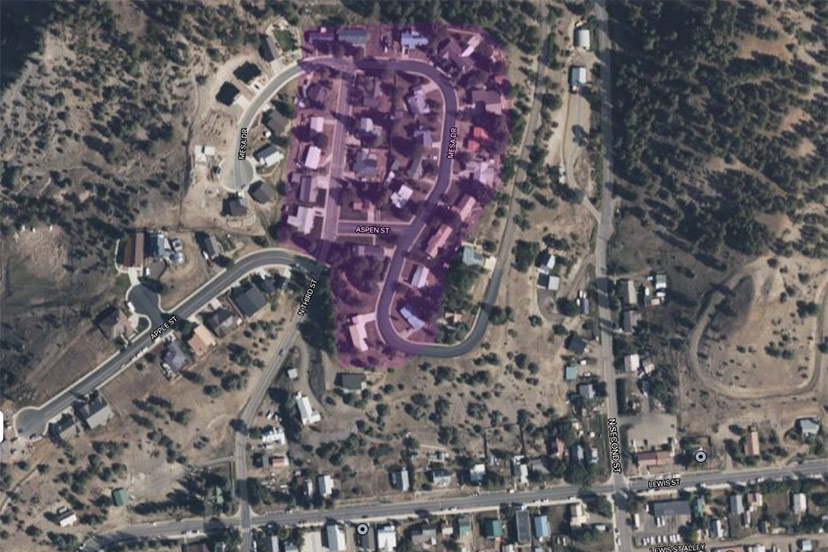The subject might seem to be Halloween, and how an old-style neighborhood — like the neighborhood that grew up along Lewis Street during Pagosa’s first 100 years, or the neighborhood that grew up on Mesa Heights during the 1960s and 1970s — develops a certain kind of social environment that attracts families during the spookiest night of the year.
Most neighborhoods in Pagosa have yet to develop the kind of character that attracts crowds of costumed children and adults at the end of October. Perhaps they will never develop it? Perhaps the suburban choices that people made during the 1980s and 1990s, when the Pagosa Lakes area and other new subdivisions were experiencing a furious construction boom, are part of the reason families hop in their cars and drive to Lewis Street and Mesa Heights on Halloween.
A suburban neighborhood has certain attractions, but maybe an older downtown neighborhood is better at encouraging social contact?
That was one of the questions knocking around in my head when I interviewed my daughter Ursala this morning, about her experience of Halloween, 2022.
A Daily Post reader told me he was looking forward to my analysis — here in Part Two — of why the Mesa Heights neighborhood holds a special attraction for young families on Halloween, and what I’d experienced there on October 31.
I told him that I hadn’t actually walked up the hill, so I couldn’t make a meaningful report.
Fortunately, my daughter and her family had made the journey.
Here’s a satellite view of the Mesa Heights neighborhood, with the older ‘historical’ family-friendly neighborhood highlighted in pink. We will learn more, in a moment, about Apple Street and the west extension of Mesa Drive — two streets that were appended to Mesa Heights over the past 20 years.
Ursala was six years old during our first Halloween in Pagosa Springs, in 1993… during our first experience of the great Mesa Heights candy giveaway. Mesa Heights was then one of the newer neighborhoods in Archuleta County, and really, it was the only ‘wealthy’ neighborhood in downtown Pagosa. Many of the neighborhood’s residents were business owners or prominent community leaders. Thinking back on her early experiences, going door to door on Halloween, Ursala recalled the ornate decorations erected in the front yards. One year, business owner Terry Smith had constructed an elegant eight-foot-tall spider; we had to walk through its legs to reach the front door.
Now, 29 years later, Ursala was experiencing Mesa Heights with her own children, ages 8 and 12. Young Simone went as a black cat; Amelie was dressed as a character from the movie ‘Nightmare Before Christmas’.
Something I didn’t know: the families living on Mesa Heights conduct a fundraising campaign — actually, a ‘candyraising’ campaign — in the weeks before Halloween, to help mitigate the economic burden of providing candy to 1,500 children each Halloween.
When I asked Ursala what types of supplicant families she saw on Mesa Heights on Monday, she described a diverse mix of economic backgrounds, walking the sidewalks. One of the few downtown neighborhoods in Pagosa with sidewalks.
“Mostly around my age, with their kids. No one drives up there. We felt safe.
“Different economic levels. I knew a lot of the families. There were not a lot of ‘high tech looking’ families…”
I asked how she was able to identify a ‘high tech’ family when she saw one on Halloween? Like… weren’t people wearing costumes?
Apparently, she was able to identify a family’s economic level by their stroller.
“The lower income families have umbrella strollers…”
The wealthier families, meanwhile, have ‘high tech’ strollers… and the children were generally wearing handmade, custom costumes, rather than costumes purchased at Walmart.
The few ‘high tech’ parents on Mesa Heights were not wearing costumes, and had expensive-looking clothing. Or so she said.
I wondered how the neighborhood had changed — from Ursala’s perspective — in recent years. Ursala estimated that about a third of the homes were dark on October 31. This was quite a change from years past, when every house welcomed the children.
Ursala and her family didn’t bother going down Apple Street or the new western extension of Mesa Drive.
“Everyone knows those are all vacation rentals. No one goes down there. It was dark; it wasn’t a way to go.”
“And it’s kind of lame, when they aren’t giving out candy.” She laughed. “That means all the other houses have to give out more candy, right? They have to cover for the other houses with no one in them…
“And so Mesa Heights has to join together, to have enough candy. So they get donations. Did you know that? The Pagosa Community Initiative helped collect candy for them, this year. Bags of candy…
“The neighborhood kind of figures it out.”
Two years ago, the Pagosa Springs Town Council — in cooperation with their staff — finally put in place some new regulations and policies aimed at preserving the residential character of downtown neighborhoods, by limiting the number of vacation rentals within the town limits. The policies established required distances between vacation rentals, and limited the number allowed in each zoning district. The limits essentially created a moratorium on new vacation rental permits.
But most of the vacation rentals in our community are located outside the town boundaries, in the unincorporated county, and the Board of County Commissioners have yet to place any controls on the number of vacation rental permits or the required distances between units. But the BOCC did establish a six-month moratorium on new permits, starting this past September.
A community task force has been meeting in secret to discuss the problems posed by the vacation rental industry.
Presumably, the secret task force will eventually make some recommendations to the BOCC.
Before it’s too late.


